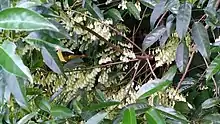Elaeocarpus culminicola
Elaeocarpus culminicola is a tree in the family Elaeocarpaceae found in parts of Malesia and Australasia. A common name is Michael's quandong.[4]
| Elaeocarpus culminicola | |
|---|---|
 | |
| Elaeocarpus culminicola flowering | |
| Scientific classification | |
| Kingdom: | Plantae |
| Clade: | Tracheophytes |
| Clade: | Angiosperms |
| Clade: | Eudicots |
| Clade: | Rosids |
| Order: | Oxalidales |
| Family: | Elaeocarpaceae |
| Genus: | Elaeocarpus |
| Species: | E. culminicola |
| Binomial name | |
| Elaeocarpus culminicola | |
| Synonyms[3] | |
| |
Description
Elaeocarpus culmanicola is an evergreen tree to 25 metres (82 ft) with a trunk diameter to 25 centimetres (9.8 in). The glossy dark green leaves are simple, crenulate, arranged spirally around the branch and crowded towards the end of the branches.[5] Flowering occurs in late winter[6] and is normally profuse. The fragrance from the flowers is strong but not particularly pleasant.[4] The flowers are white, about 10 millimetres (0.39 in) across and are attached to the twig behind or below the leaves. Like many other members of this genus they are cup-shaped and hang downwards with fringed petals that give the appearance of "fairy petticoats" (a common name for E. reticulatus).[7] The bright blue globular fruit is a drupe about 10 millimetres (0.39 in) diameter which appears in late spring and may stay on the branch until the next flowering.[8]
Range and habitat
Elaeocarpus culmanicola is native to the Philippines, Sulawesi, Maluku Islands, New Guinea, Bismarck Archipelago, and the Northern Territory and Queensland in Australia,[4][9] where it is an understorey tree in well developed rainforest. It is often associated with wet or swampy conditions.[4]
Uses
Fruits are eaten by Cassowaries.[8] The timber is a commercial hardwood.[5]
Gallery
 Leaves of E. culminicola
Leaves of E. culminicola E. culminicola fruiting
E. culminicola fruiting.jpg.webp) Specimen from Auckland Museum
Specimen from Auckland Museum
References
- Botanic Gardens Conservation International (BGCI).; IUCN SSC Global Tree Specialist Group. (2018). "Elaeocarpus culminicola". IUCN Red List of Threatened Species. 2018: e.T135895736A135895738. doi:10.2305/IUCN.UK.2018-2.RLTS.T135895736A135895738.en. Retrieved 2020-10-11.
- "Elaeocarpus culminicola". International Plant Names Index. Retrieved 2020-09-19.
- "Elaeocarpus culmanicola Warb". The Plant List. Retrieved 2020-09-19.
- "Factsheet - Elaeocarpus culminicola". Retrieved 2020-09-19.
- "PNGTreesKey - Elaeocarpus culminicola Warb". Guide to the Trees of Papua New Guinea. Retrieved 2020-09-19.
- Jones, David L. (1986). Rainforest Plants of Australia. Reed Books. p. 141. ISBN 0730103811.
- "Growing Native Plants - Australian National Botanic Gardens". Retrieved 2020-09-19.
- Cooper, William; Cooper, Wendy (1994). Fruits of the Rainforest - A Guide to Fruits in Australian Tropical Rain Forests. GEO Productions. p. 106. ISBN 0646198033.
- "Elaeocarpus culminicola Warb., Plants of the World Online, Kew Science". Retrieved 2020-09-19.
